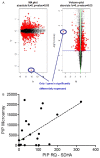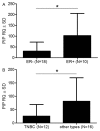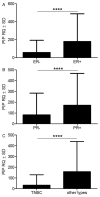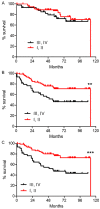Prolactin-induced protein as a potential therapy response marker of adjuvant chemotherapy in breast cancer patients
- PMID: 27293986
- PMCID: PMC4889707
Prolactin-induced protein as a potential therapy response marker of adjuvant chemotherapy in breast cancer patients
Abstract
Many studies are dedicated to exploring the molecular mechanisms of chemotherapy-resistance in breast cancer (BC). Some of them are focused on searching for candidate genes responsible for this process. The aim of this study was typing the candidate genes associated with the response to standard chemotherapy in the case of invasive ductal carcinoma. Frozen material from 28 biopsies obtained from IDC patients with different responses to chemotherapy were examined using gene expression microarray, Real-Time PCR (RT-PCR) and Western blot (WB). Based on the microarray results, further analysis of candidate gene expression was evaluated in 120 IDC cases by RT-PCR and in 224 IDC cases by immunohistochemistry (IHC). The results were correlated with clinical outcome and molecular subtype of the BC. Gene expression microarray revealed Prolactin-Induced Peptide (PIP) as a single gene differentially expressed in BC therapy responder or non-responder patients (p <0.05). The level of PIP expression was significantly higher in the BC therapy responder group than in the non-responder group at mRNA (p=0.0092) and protein level (p=0.0256). Expression of PIP mRNA was the highest in estrogen receptor positive (ER+) BC cases (p=0.0254) and it was the lowest in triple negative breast cancer (TNBC) (p=0.0336). Higher PIP mRNA expression was characterized by significantly longer disease free survival (DFS, p=0.0093), as well as metastasis free survival (MFS, p=0.0144). Additionally, PIP mRNA and PIP protein expression levels were significantly higher in luminal A than in other molecular subtypes and TNBC. Moreover significantly higher PIP expression was observed in G1, G2 vs. G3 cases (p=0.0027 and p=0.0013, respectively). Microarray analysis characterized PIP gene as a candidate for BC standard chemotherapy response marker. Analysis of clinical data suggests that PIP may be a good prognostic and predictive marker in IDC patients. Higher levels of PIP were related to longer DFS and MFS but not with OS.
Keywords: PIP; adjuvant chemotherapy; breast cancer.
Figures














References
-
- Siegel R, Naishadham D, Jemal A. Cancer statistics, 2013. CA Cancer J Clin. 2013;63:11–30. - PubMed
-
- Goldhirsch A, Wood WC, Coates AS, Gelber RD, Thürlimann B, Senn HJ, members P. Strategies for subtypes--dealing with the diversity of breast cancer: highlights of the St. Gallen International Expert Consensus on the Primary Therapy of Early Breast Cancer 2011. Ann Oncol. 2011;22:1736–1747. - PMC - PubMed
-
- Pagani A, Sapino A, Eusebi V, Bergnolo P, Bussolati G. PIP/GCDFP-15 gene expression and apocrine differentiation in carcinomas of the breast. Virchows Arch. 1994;425:459–465. - PubMed
LinkOut - more resources
Full Text Sources
